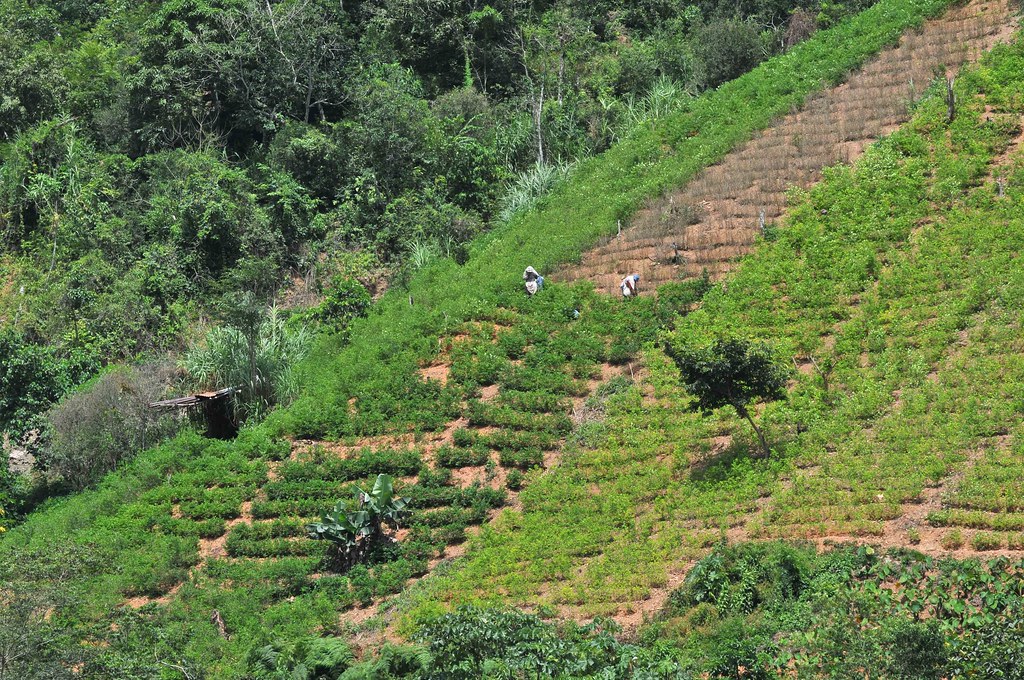
Over the last few years, coca paste prices have significantly decreased, sparking a crisis among Colombian growers, known as “cocaleros”. The price of coca paste has dropped so much that a kilogram is now being sold at US$375 (around 1.5 million COP), compared to its 2021 value of US$600 (2.3 million COP). With current prices at an all-time low, producing coca paste is no longer profitable, and cocaleros are being forced to adapt their practices.
An overproduction crisis
This crisis is attributed to two main factors. First is the exponential growth in coca cultivation across Colombia in recent years.
According to the United Nations Office on Drugs and Crime, in 2022, coca cultivation covered 230,000 hectares, establishing Colombia as the world’s leading producer, accounting for approximately 60% of global production, ahead of even Peru and Bolivia.
This area has likely increased, with some estimates suggesting up to 250,000 hectares. As production reaches record highs, the market faces an oversupply crisis, causing prices to drop due to supply exceeding demand, that is, the drug cartels’ selling capacities.
Moreover, coca cultivation is expanding in other countries, including Peru and Bolivia, but also Venezuela, Ecuador and Honduras, making the international market more competitive for Colombian coca growers.
The second major factor involves conflicts between narco groups, such as the ELN and the powerful Clan del Golfo, which directly affect the cocaleros. Indeed, retaliation against communities supplying rival groups is a common practice, discouraging growers from continuing their operations.
The coca industry’s weight in Colombian economy
Coca cultivation is a significant economic sector in Colombia. It is estimated that more than 230,000 farming families live off coca cultivation, with an additional 170,000 families using this activity as a secondary source of income. As such, coca cultivation and coca paste production generates an estimated $1.2 billion (4,710 trillion COP) in economic activity within the country.
The drop in coca paste prices has had profound effects on the livelihoods of Colombian farmers, leading to a restructuring of their activities. To avoid food insecurity and poverty resulting from the crisis, many farmers have diversified their income sources, transitioning to other crops like coffee and cacao. However, most have begun engaging in alternative activities, such as illegal mining.
This business has been boosted by market fluctuations and a rise in the price of gold, and is now also engaged in by drug cartels and armed groups. While it presents fewer risks than the production of coca paste, it is 50 times more profitable. It is estimated that, in 2021, nearly 30% of the gold exported by Colombia was illegally mined.
Colombia’s efforts against coca production
In recent years, Colombia’s efforts to encourage a shift to alternative crops have faced significant challenges.
Following the 2016 peace agreement with the FARC, President Juan Manuel Santos encouraged nearly 100,000 families to transition from coca cultivation to other crops. However, the lack of technical help for the peasant farmers, combined with the subsequent freezing of the program by President Santos’ successor, Ivan Duque, led to the opposite effect.
This trend has been further accelerated since the inauguration of President Gustavo Petro, who has slowed down the coca crop eradication program. Indeed, between 2022 and 2023, the number of hectares eradicated dropped from 69,000 to only 20,000.
While the official goal of the Colombian administration is to reduce coca production by 40% before 2026, it seems unlikely that this objective will be achieved. In fact, the war on drugs initiated under Plan Colombia has so far not been very effective. The figures speak for themselves: when the program launched, coca cultivation covered around 170,000 hectares; it has now expanded to over 230,000 hectares.
As the United States has recently called on Colombia to increase eradication of coca crops, the Petro administration will need to take new and effective measures in this regard.
See all the latest news from Colombia and the world at ColombiaOne.com. Contact our newsroom to report an update or send your story, photos and videos. Follow Colombia One on Google News, Facebook, Instagram, and subscribe here to our newsletter.

